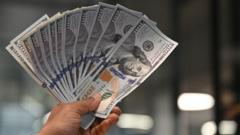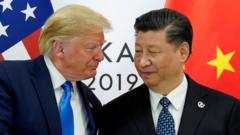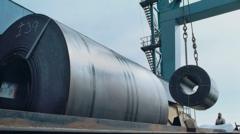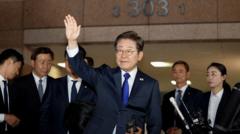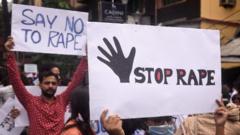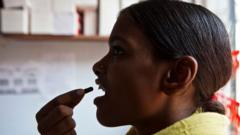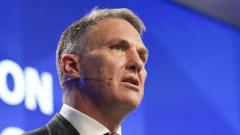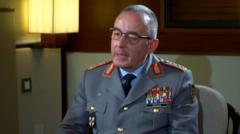The discussions focused on trade, defense, and strategic cooperation as both nations navigate looming tariff challenges and seek mutually beneficial agreements.
Trade Advances: Modi and Vance Discuss Future Cooperation Amid Tariff Concerns
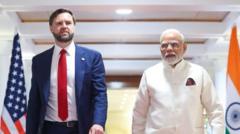
Trade Advances: Modi and Vance Discuss Future Cooperation Amid Tariff Concerns
A meeting between India's Prime Minister Narendra Modi and US Vice President JD Vance signals advancements in bilateral trade negotiations.
In a significant meeting held in Delhi, Prime Minister Narendra Modi and US Vice President JD Vance addressed ongoing negotiations for a bilateral trade deal amidst the threat of rising tariffs. Vance, accompanied by his wife Usha and their three children, is on a four-day visit to India that combines both official duties and personal exploration of Indian heritage.
"We are committed to mutually beneficial cooperation in crucial areas such as trade, technology, defense, energy, and people-to-people exchanges," Modi emphasized on X after their discussions. The Indian Prime Minister also hosted a dinner for the Vance family at his residence, reinforcing the connection between the two leaders, who have developed a warm relationship over time.
India is among several countries currently negotiating trade agreements with the United States while President Donald Trump has paused higher tariffs. This pause, set to end on July 9, comes after the US planned to impose a staggering 27% tariff on Indian goods. In light of this, both Delhi and Washington have been striving for an early conclusion to their trade dialogues.
Despite the personal rapport between Modi and Trump, the latter has criticized India's trade practices, labeling it a "tariff king" and a "big abuser" of trade agreements. Recently, US Trade Representative Jamieson Greer underscored the "serious lack of reciprocity" prevailing in the trade relationship, hinting at ongoing challenges.
India has proactively reduced tariffs on several goods recently and is rumored to be contemplating further tariff reductions to appease American concerns. However, contentious areas such as agriculture remain significant hurdles, especially as the US seeks to increase its access to the Indian market for products like corn, while India maintains its protective stance.
Beyond trade, Modi and Vance discussed potential partnerships in defense and strategic technologies, reflecting the multifaceted nature of Indo-US relations. Modi has also expressed eagerness to host Trump in India later this year during the anticipated Quad summit.
Following their meeting, Modi presented peacock feathers, symbolizing goodwill, to Vance’s children, who were notably dressed in traditional Indian attire upon their arrival—a nod to Usha Vance's Indian heritage from Andhra Pradesh. The family’s journey continues with planned visits to Jaipur and the Taj Mahal, providing an enriching blend of diplomacy and cultural discovery.
As this meeting unfolds, the trajectory of US-India trade relations remains a focal point, with both parties navigating the complexities of protectionism and cooperation in an evolving global landscape.
"We are committed to mutually beneficial cooperation in crucial areas such as trade, technology, defense, energy, and people-to-people exchanges," Modi emphasized on X after their discussions. The Indian Prime Minister also hosted a dinner for the Vance family at his residence, reinforcing the connection between the two leaders, who have developed a warm relationship over time.
India is among several countries currently negotiating trade agreements with the United States while President Donald Trump has paused higher tariffs. This pause, set to end on July 9, comes after the US planned to impose a staggering 27% tariff on Indian goods. In light of this, both Delhi and Washington have been striving for an early conclusion to their trade dialogues.
Despite the personal rapport between Modi and Trump, the latter has criticized India's trade practices, labeling it a "tariff king" and a "big abuser" of trade agreements. Recently, US Trade Representative Jamieson Greer underscored the "serious lack of reciprocity" prevailing in the trade relationship, hinting at ongoing challenges.
India has proactively reduced tariffs on several goods recently and is rumored to be contemplating further tariff reductions to appease American concerns. However, contentious areas such as agriculture remain significant hurdles, especially as the US seeks to increase its access to the Indian market for products like corn, while India maintains its protective stance.
Beyond trade, Modi and Vance discussed potential partnerships in defense and strategic technologies, reflecting the multifaceted nature of Indo-US relations. Modi has also expressed eagerness to host Trump in India later this year during the anticipated Quad summit.
Following their meeting, Modi presented peacock feathers, symbolizing goodwill, to Vance’s children, who were notably dressed in traditional Indian attire upon their arrival—a nod to Usha Vance's Indian heritage from Andhra Pradesh. The family’s journey continues with planned visits to Jaipur and the Taj Mahal, providing an enriching blend of diplomacy and cultural discovery.
As this meeting unfolds, the trajectory of US-India trade relations remains a focal point, with both parties navigating the complexities of protectionism and cooperation in an evolving global landscape.



